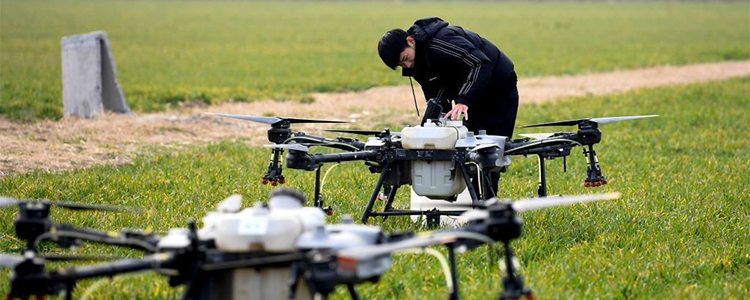New technology, new era. The development of plant protection drones has indeed brought new markets and opportunities to agriculture, especially in terms of agricultural demographic restructuring, serious aging and increasing labor costs. The widespread of digital agriculture is the current urgent problem of agriculture and the inevitable trend of future development.
The plant protection drone is a versatile device, commonly used in agriculture, plantation, forestry and other industries. It has a variety of operating modes as well as sowing and spraying functions, which can realize seeding, fertilizing, spraying pesticides and other operations. Next we talk about the use of agricultural plant protection drones in agriculture.
1. Crop spraying

Compared with traditional pesticide spraying methods, plant protection drones can achieve automatic quantification, control and spraying of pesticides in small quantities, with much higher efficiency than suspended sprayers. When agricultural plant protection drones spray pesticides, the downward airflow generated by the rotor helps increase the penetration of pesticides on crops, saving 30%-50% of pesticides, 90% of water consumption and reducing the impact of polluting pesticides on soil and the environment.
2. Crop planting & seeding

Compared with traditional agricultural machinery, the degree and efficiency of UAV seeding and fertilization are higher, which is conducive to large-scale production. And the drone is small in size, easy to transfer and transport, and not restricted by terrain conditions.
3. On-farm irrigation

During crop growth, farmers must know and adjust the soil moisture suitable for crop growth at all times. Use plant protection drones to fly in the field and observe the different color changes of farm soil at different moisture levels. Digital maps are later created and stored in a database for use, so that the information stored in the database can be identified and compared to solve scientific and rational irrigation problems. In addition, the drone can be used to observe the phenomenon of wilting of plant leaves, stems and shoots caused by insufficient soil moisture in farmland, which can be used as a reference to determine whether crops need irrigation and watering, thus achieving the purpose of scientific irrigation and water conservation.
4. Farmland Information Monitoring

It mainly includes pest and disease monitoring, irrigation monitoring and crop growth monitoring, etc. This technology can provide a comprehensive understanding of the crop growth environment, cycle and other indicators, pointing out problem areas that cannot be detected by the naked eye, from irrigation to soil variation to pests and bacteria invasion, and facilitating farmers to better manage their fields. UAV farmland information monitoring has the advantages of wide range, timeliness, objectivity and accuracy, which are unmatched by conventional monitoring means.
5. Agricultural Insurance Survey

Inevitably, crops are attacked by natural disasters during the growing process, causing losses to farmers. For farmers with small crop areas, regional surveys are not difficult, but when large areas of crops are naturally damaged, the workload of crop surveys and damage assessment is extremely heavy, making it difficult to accurately define the problem of loss areas. In order to measure the actual damage area more effectively, agricultural insurance companies have carried out agricultural insurance disaster loss surveys and applied drones to agricultural insurance claims. UAVs have the technical characteristics of mobility and flexibility, rapid response, high-resolution images and high-precision positioning data acquisition, various mission equipment application expansion, and convenient system maintenance, which can perform the task of disaster damage determination. Through post-processing and technical analysis of aerial survey data, aerial photographs, and comparison and correction with field measurements, insurance companies can more accurately determine the actual affected areas. Drones are affected by disasters and damages. Agricultural plant protection drones have solved the problems of difficult and weak timeliness of agricultural insurance claims investigation and damage determination, greatly improving the speed of investigation, saving a lot of manpower and material resources, and ensuring the accuracy of claims while improving the payout rate.
The operation of agricultural drones is very simple. The grower only needs to press the corresponding button through the remote control, and the aircraft will complete the corresponding action. In addition, the drone also has a "ground-like flight" function, which automatically maintains the height between the body and the crop according to changes in the terrain, thus ensuring that the height remains constant.
Post time: Mar-07-2023